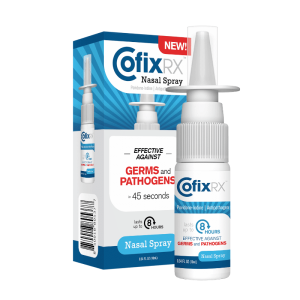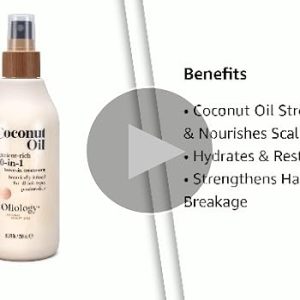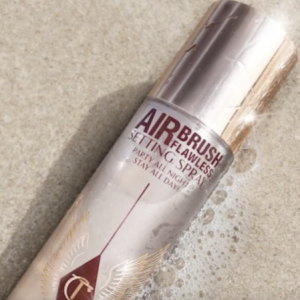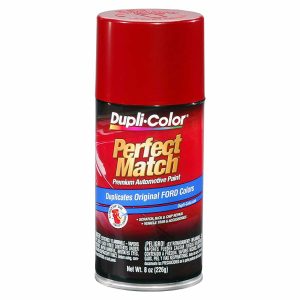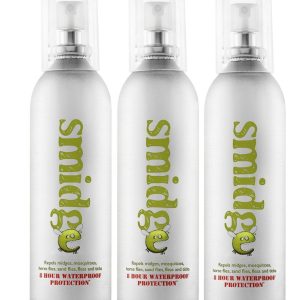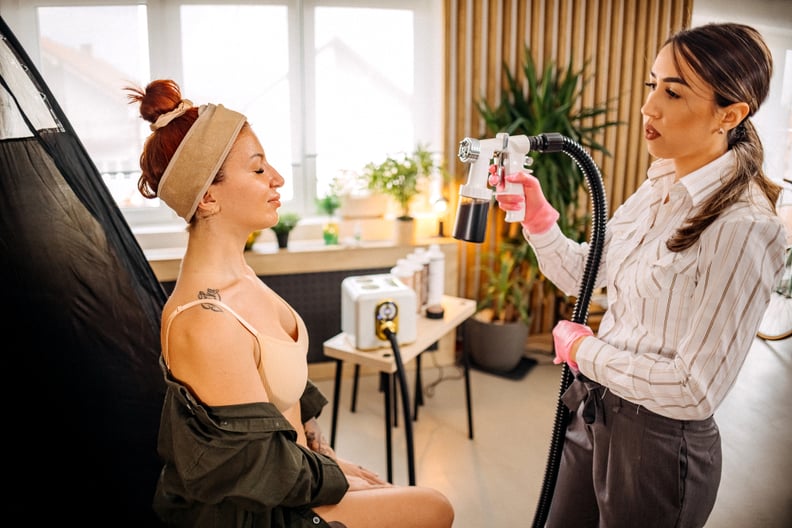
Getting that perfect sun-kissed glow without harmful UV exposure has made spray tanning increasingly popular among beauty enthusiasts. However, one of the most common questions people ask before booking their first appointment is: how long does a spray tan last? Understanding the duration and factors that influence your tan’s longevity can help you plan your treatments effectively and get the most value from your investment.
The answer isn’t straightforward because spray tan duration varies significantly based on multiple factors including your skin type, preparation routine, aftercare practices, and the quality of products used. Professional spray tans typically last between 5-10 days, but with proper care and maintenance, some people can extend their golden glow for up to two weeks.
What Determines How Long Your Spray Tan Will Last?
Understanding the science behind spray tan longevity helps you make informed decisions about your tanning routine. The duration depends on three primary factors: what you do to your skin beforehand, how much dihydroxyacetone (DHA) is in the solution, and how you care for your skin afterward. Let’s explore each of these critical elements in detail.
Dihydroxyacetone (DHA) Concentration
DHA is the active ingredient in spray tan solutions that creates the bronze color by reacting with amino acids in your skin’s outer layer. Higher concentrations of DHA typically result in darker, longer-lasting tans. Professional-grade solutions often contain between 8-14% DHA, which provides optimal color development and longevity compared to at-home products that may contain only 2-4% DHA.
The chemical reaction between DHA and your skin continues for up to 24 hours after application, which is why your tan deepens during this development period. This gradual process creates a more natural-looking color that tends to fade more evenly than instant bronzers or makeup-based tanning products.
Your Natural Skin Type and Condition
Different skin types retain spray tan color for varying durations: fair skin typically experiences fading around 5-7 days, medium to olive skin tones last 7-10 days, while darker skin tones can maintain their enhanced glow for up to 10 days. This variation occurs because different skin types have varying cell turnover rates and natural oil production levels.
Dry skin tends to absorb more product initially but also sheds faster, potentially shortening your tan’s lifespan. Oily skin may resist the tanning solution during application but often holds color longer once properly developed. Sensitive skin requires special consideration as it may react differently to DHA and fade more quickly in response to irritation.
Body Area Variations
Different parts of your body fade at different rates, with areas having relatively thin skin or greater exposure to water, soap, or weather fading faster. The color on your face and hands could fade in as little as three days, while skin on your stomach and back remains tan longer.
High-wear areas that fade fastest include:
- Hands and feet (frequent washing)
- Face and neck (daily cleansing routines)
- Joints like elbows and knees (frequent movement and friction)
- Areas that sweat heavily during exercise
Protected areas that maintain color longest:
- Torso and back
- Upper arms and thighs
- Areas covered by clothing most of the time
Pre-Tan Preparation: Setting the Foundation for Longevity
Proper preparation is crucial for maximizing how long your spray tan lasts. The condition of your skin before application directly impacts both the initial results and the duration of your tan. Professional tanning technicians often say that preparation accounts for 70% of your tan’s success.
Exfoliation: The 24-48 Hour Rule
Exfoliating 24-48 hours before your appointment removes dead skin cells that would otherwise cause uneven application and premature fading. Use a gentle, oil-free scrub focusing on rough areas like elbows, knees, ankles, and heels. Avoid harsh scrubs immediately before your appointment as they can leave your skin sensitive and prone to over-absorption.
Best exfoliation practices:
- Use circular motions with moderate pressure
- Pay extra attention to callused areas
- Rinse thoroughly to remove all scrub residue
- Avoid oil-based products that can create barriers
Hydration Without Barriers
Well-moisturized skin provides an even canvas for spray tan application, but timing is crucial. Moisturize regularly in the days leading up to your appointment, but avoid lotions, deodorants, perfumes, and makeup on the day of your session. These products can create barriers that prevent proper DHA absorption.
Pre-tan skin preparation checklist:
- Shave 24 hours before (not the day of)
- Remove all makeup and deodorant
- Avoid oil-based products for 24 hours
- Wear loose, dark clothing to your appointment
- Remove jewelry that might leave tan lines
Professional vs. At-Home: Duration Differences
The longevity of your spray tan significantly depends on whether you choose professional application or at-home products. Professional spray tans consistently last longer due to higher-quality solutions, proper application techniques, and customized formulations for your skin type.
Professional Spray Tan Duration
Professional spray tans typically last around 7-10 days with proper preparation and aftercare. Professional technicians use commercial-grade equipment that ensures even application and can adjust the solution concentration based on your desired outcome and skin type.
Advantages of professional application:
- Higher DHA concentration (8-14%)
- Even, streak-free application
- Customized color matching
- Professional aftercare guidance
- Organic and premium ingredients
At-Home Product Longevity
At-home spray tan products generally last 3-7 days, depending on the quality and your application technique. While more convenient and cost-effective, they typically contain lower DHA concentrations and may not provide the even coverage achieved by professional applications.
Factors affecting at-home duration:
- Product quality and DHA percentage
- Application technique and coverage
- Environmental conditions during application
- Personal skill level and experience
Maximizing Your Spray Tan Duration: Expert Aftercare Tips
The first 24-48 hours after your spray tan application are critical for color development and longevity. During this time, your skin is still processing the DHA, and proper care can significantly extend how long your spray tan lasts.
The First 8-12 Hours: Development Period
Immediately after your spray tan, avoid water, sweating, and tight clothing that could cause the solution to rub off before it fully develops. The bronzer (temporary color) you see initially will wash off during your first shower, revealing your true tan underneath.
Critical first-day guidelines:
- Wait 8-12 hours before showering
- Avoid exercise or activities that cause sweating
- Wear loose, dark clothing
- Sleep on dark sheets
- Avoid applying any products to your skin
Post-Development Care
Once your tan has fully developed, focus on maintaining moisture levels and protecting your skin from excessive exfoliation. The key is finding the right balance between cleanliness and preservation.
Daily maintenance routine:
- Use lukewarm water instead of hot
- Choose sulfate-free, gentle cleansers
- Pat dry with a towel instead of rubbing
- Apply moisturizer while skin is still damp
- Use a tan-extending lotion with light DHA
Weekly Touch-Up Strategies
With proper care and attention, some individuals report their spray tans lasting up to 2 weeks or even longer. Strategic touch-ups can help maintain your glow without requiring a full reapplication.
Touch-up techniques:
- Apply gradual tanning lotion to fading areas
- Focus on high-wear zones like hands and face
- Use tinted moisturizers for subtle color maintenance
- Schedule professional touch-ups for special events
Factors That Can Shorten Your Tan’s Lifespan
Several lifestyle factors and external influences can cause your spray tan to fade more quickly than expected. Being aware of these factors helps you make informed decisions about timing your tanning appointments and adjusting your routine accordingly.
Water Exposure and Activities
Chlorinated pools, hot tubs, and saltwater can accelerate tan fading by stripping the color from your skin’s outer layer. If you must swim, apply a waterproof barrier cream and rinse immediately afterward with fresh water.
Water-related factors:
- Chlorine breaks down DHA molecules
- Salt water has an exfoliating effect
- Hot water opens pores and accelerates fading
- Excessive sweating can cause streaking
Skincare Products and Medications
Certain medications or skincare products containing alpha-hydroxy acids or retinoids may impact the tan’s longevity. These ingredients increase cell turnover, causing your tan to fade more rapidly.
Products to avoid or use cautiously:
- Retinoids and tretinoin
- Alpha-hydroxy acids (AHAs)
- Beta-hydroxy acids (BHAs)
- Benzoyl peroxide
- Strong anti-aging serums
Hormonal Factors
Hormonal changes during menopause can lead to drier skin, which may over-absorb the tanning solution, and common hot flashes can lead to sweating during development. Understanding how your body’s changes affect tanning results helps you adjust your approach accordingly.
Hormonal considerations:
- Menstrual cycle affects skin hydration
- Pregnancy can change skin sensitivity
- Medications may alter skin condition
- Stress levels impact skin health
Skin Type-Specific Duration Expectations
Different skin types not only require different approaches to spray tanning but also experience varying durations of color retention. Understanding your skin type helps set realistic expectations and choose appropriate aftercare products.
Fair and Sensitive Skin
Fair skin typically shows spray tan results most dramatically but may also fade more quickly due to faster cell turnover. Those with sensitive skin need to be particularly careful about product selection and aftercare routines.
Fair skin considerations:
- Start with lighter solutions to avoid orange tones
- May need more frequent touch-ups
- Requires gentle, fragrance-free aftercare products
- Benefits from gradual tanning lotions for maintenance
Medium and Olive Skin Tones
Medium to olive skin tones tend to retain color better, often lasting 7-10 days. These skin types typically have more natural melanin, which helps the spray tan blend seamlessly and fade more evenly.
Medium skin advantages:
- More forgiving of application mistakes
- Natural undertones complement spray tan colors
- Generally experiences even fading
- Can handle slightly higher DHA concentrations
Darker Skin Tones
People with darker skin often wonder if spray tanning is worthwhile, but it can add beautiful depth and radiance while evening out skin tone. The enhancement may be more subtle but often lasts the longest.
Darker skin benefits:
- Longest-lasting results (up to 10+ days)
- Natural melanin protects against orange tones
- Provides beautiful enhancement rather than dramatic change
- Less noticeable when fading begins
Seasonal Considerations for Spray Tan Longevity
The time of year you get your spray tan can significantly impact how long it lasts. Seasonal factors like humidity, temperature, clothing choices, and activity levels all play roles in determining duration.
Summer Spray Tanning
Summer presents unique challenges for spray tan longevity due to increased sweating, swimming, and sun exposure. However, it’s also when most people want to maintain a consistent tan.
Summer factors affecting duration:
- Increased sweating from heat and humidity
- More frequent showering and swimming
- Lighter clothing that may rub against skin
- Higher activity levels and outdoor time
Summer maintenance tips:
- Schedule tans more frequently (every 5-7 days)
- Use waterproof products when swimming
- Apply extra moisturizer in air-conditioned environments
- Consider lighter tan shades for more natural fading
Winter Spray Tanning
Winter conditions can actually help extend spray tan duration due to reduced sweating and water exposure. However, indoor heating and harsh weather can dry out skin, potentially causing uneven fading.
Winter advantages:
- Less sweating and water exposure
- Clothing provides protection from rubbing
- Reduced outdoor activity minimizes fading
- Consistent indoor temperatures
Winter challenges:
- Dry indoor air requires extra moisturizing
- Hot showers feel better but accelerate fading
- Less natural light may make color appear different
- Seasonal skin changes affect absorption
Common Mistakes That Reduce Spray Tan Duration
Even with the best intentions, certain mistakes can significantly shorten how long your spray tan lasts. Learning from common errors helps you avoid disappointment and get better value from your tanning investment.
Preparation Mistakes
Skipping or inadequately performing pre-tan preparation is one of the most common reasons for poor longevity. Many people underestimate the importance of proper exfoliation and skin preparation.
Common prep errors:
- Exfoliating too close to appointment time
- Using oil-based products before application
- Forgetting to remove deodorant or makeup
- Not addressing problem areas like rough elbows
Aftercare Mistakes
The period immediately following your spray tan is crucial, yet many people inadvertently damage their results through improper aftercare practices.
Frequent aftercare errors:
- Showering too soon after application
- Using harsh soaps or scrubs
- Applying regular lotions instead of tan-safe products
- Exercising heavily before full development
Maintenance Mistakes
Long-term care decisions significantly impact how gracefully your tan fades and how long the color remains attractive.
Maintenance oversights:
- Inconsistent moisturizing routine
- Using products with fading ingredients
- Not protecting tan during swimming
- Ignoring early signs of uneven fading
How to Remove Spray Foam Off Hands and Other Mishaps
While discussing spray tan longevity, it’s worth addressing what to do when application goes wrong or when you need to remove your tan early. Sometimes how to get spray foam off hands becomes a pressing concern, especially if you’ve had an uneven application or need to reset for a special event.
Safe removal methods:
- Gentle exfoliation with a mitt or scrub
- Lemon juice and baking soda paste for stubborn areas
- Professional removal treatments at salons
- Oil-based treatments to break down DHA
When to consider removal:
- Uneven or streaky application
- Color turned out too dark or orange
- Special event requiring a fresh start
- Allergic reaction or skin irritation
Advanced Tips for Extended Spray Tan Longevity
Experienced spray tan enthusiasts often develop sophisticated routines that help them achieve maximum duration from their treatments. These advanced strategies go beyond basic aftercare to create optimal conditions for long-lasting results.
Layering Technique
Some people achieve longer-lasting results by building their tan gradually through multiple lighter applications rather than one dark session. This approach can extend overall duration while providing more natural-looking results.
Layering benefits:
- More even color distribution
- Better color matching to skin tone
- Extended overall duration
- Easier maintenance and touch-ups
Product Rotation Strategy
Using different types of tanning products strategically can help maintain color between professional applications while extending the overall duration of your tan.
Rotation approach:
- Professional spray tan as base
- Gradual tanning lotion for maintenance
- Tinted moisturizer for daily enhancement
- Strategic touch-ups for problem areas
Environmental Optimization
Creating the ideal environment for spray tan development and maintenance involves controlling factors like humidity, temperature, and air circulation in your home.
Environmental factors:
- Maintain moderate humidity levels
- Avoid excessive air conditioning
- Control water temperature in showers
- Choose appropriate sleepwear and bedding
The Science Behind Spray Tan Fading
Understanding the biological and chemical processes involved in spray tan fading helps explain why certain factors affect duration and how to work with your skin’s natural processes rather than against them.
Cell Turnover and Exfoliation
Your skin naturally sheds dead cells every 28-30 days, but this process varies by individual and body area. The spray tan color exists in these outer skin cells, so as they shed, your tan fades.
Natural exfoliation factors:
- Age affects cell turnover rate
- Hormones influence skin regeneration
- Nutrition impacts skin health
- Genetics determine individual variation
DHA Chemistry and Degradation
The chemical reaction between DHA and amino acids in your skin isn’t permanent. Over time, the color molecules break down naturally, contributing to the fading process.
Chemical considerations:
- DHA continues reacting for 24-48 hours
- Color molecules gradually degrade
- Environmental factors accelerate breakdown
- Quality of DHA affects stability
Cost-Effectiveness: Planning Your Spray Tan Schedule
Understanding how long spray tans last helps you plan your tanning schedule for maximum cost-effectiveness. Whether you’re preparing for a special event or maintaining year-round color, strategic timing saves money while ensuring consistent results.
Event-Based Planning
For special occasions like weddings, vacations, or photo shoots, timing your spray tan application is crucial for optimal results.
Event planning timeline:
- 2-3 days before: Ideal for peak color
- 1 day before: Risk of too-dark results
- 4-5 days before: May need touch-ups
- Week before: Good for testing and adjustments
Maintenance Schedule Options
Different maintenance approaches suit different lifestyles and budgets, from occasional touch-ups to regular professional appointments.
Schedule options:
- Weekly professional: Consistent color, higher cost
- Bi-weekly professional: Good balance of cost and results
- Monthly professional with at-home maintenance: Budget-friendly
- Seasonal professional: Minimal but strategic timing
Health Considerations and Spray Tan Duration
While spray tans are generally considered safer than UV tanning, certain health factors can affect both the safety and duration of your results. Being aware of these considerations helps you make informed decisions about frequency and products.
Skin Health Impact
Regular spray tanning typically doesn’t harm skin health when done properly, but individual sensitivities can affect both comfort and duration.
Health considerations:
- Allergic reactions to DHA or other ingredients
- Skin conditions that affect absorption
- Medications that increase sensitivity
- Pregnancy-related skin changes
Frequency Guidelines
While there’s no strict limit on spray tan frequency, allowing your skin time between applications promotes healthier results and better longevity.
Recommended frequency:
- Maximum: Weekly professional applications
- Optimal: Every 10-14 days for most people
- Minimum: Monthly for maintenance
- Breaks: Periodic skin rest periods
Ready to Experience Long-Lasting Spray Tan Results?
Now that you understand exactly how long spray tans last and the factors that influence duration, you’re equipped to make informed decisions about your tanning routine. Remember that with proper preparation, quality products, and dedicated aftercare, you can achieve results that last up to 10 days or even longer.
The key to maximizing your spray tan investment lies in understanding your unique skin type, following professional guidance, and maintaining consistent care routines. Whether you choose professional applications or at-home products, the principles remain the same: prepare properly, care consistently, and adjust your approach based on your individual results.
Consider booking a consultation with a professional spray tan technician who can assess your skin type and recommend the best approach for achieving your desired duration and color goals. With the right strategy, you can enjoy beautiful, sun-kissed skin year-round while protecting your health and maximizing the longevity of each application.
Frequently Asked Questions
How long does a spray tan last on average?
A professional spray tan typically lasts 7-10 days on average, while at-home products generally last 3-7 days. The exact duration depends on your skin type, preparation, and aftercare routine.
Can I make my spray tan last longer than 10 days?
Yes, with proper care and attention, some individuals report their spray tans lasting up to 2 weeks or even longer. This requires excellent preparation, consistent moisturizing, and avoiding activities that cause excessive fading.
Why does my spray tan fade faster on some body parts?
Areas with thin skin or frequent exposure to water, soap, or friction fade faster, such as hands and face (3 days), while protected areas like the torso maintain color longer.
Does skin type affect how long a spray tan lasts?
Yes, fair skin typically experiences fading around 5-7 days, medium to olive skin lasts 7-10 days, while darker skin tones can maintain enhanced color for up to 10 days.
What’s the difference between professional and at-home spray tan duration?
Professional spray tans use higher DHA concentrations (8-14%) and proper application techniques, typically lasting 7-10 days. At-home products contain lower DHA (2-4%) and generally last 3-7 days depending on application quality.
Can certain products make my spray tan fade faster?
Yes, skincare products containing alpha-hydroxy acids or retinoids may impact tan longevity by increasing cell turnover and accelerating the natural fading process.
How soon can I get another spray tan after my current one fades?
You can get a new spray tan as soon as your previous one has faded significantly, typically after 7-10 days. Some people prefer to wait until complete fading for the most even results, while others layer new applications over partially faded tans.
Does the season affect how long my spray tan will last?
Yes, summer factors like increased sweating, swimming, and sun exposure can shorten duration to 5-7 days, while winter conditions with less water exposure and activity may extend duration to 8-12 days.
